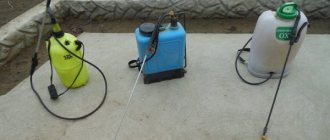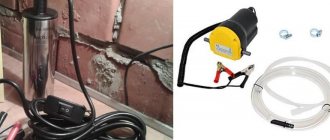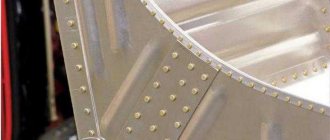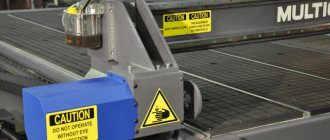A vacuum pump is a regular air compressor that uses the suction side.
You can make a 12 volt vacuum pump out of an air compressor if you can connect a hose to its air intake.
This guide will show you how to make a vacuum pump with your own hands. Such a device is useful for vacuumizing food products and increasing their shelf life, or for vacuum packaging things, since a bag with removed air takes up less space than a regular bag with things. You can also do vacuum molding - the production of products from thermoplastic materials in hot form using vacuum.
The vacuum created by such a device is several times higher than what a conventional vacuum cleaner can create (about 0.8 kgf/sq.cm, or 0.08 MPa).
This vacuum is sufficient to use the pump for industrial purposes that require vacuum.
A compressor for inflating car tires in a store costs about 1,300 rubles. You will also have to purchase some spare parts and glue.
You will also need:
- About one meter of PVC tube with an internal diameter of 6 mm.
- Plastic herringbone connector for 6mm ID tubing.
- Epoxy resin (cold welding).
All of these materials are readily available and can be purchased at the store.
Since a 12V pump draws about 4A of current, it will need a fairly powerful DC power supply. A 6 A car charger can be used as a power source.
NOTES.
If you use a cheap air compressor to inflate your tires, like the $700 Harbor Freight one, don't expect too much from it. (A cheap pump will only work for a few minutes, then it will overheat. A good compressor can work continuously for up to an hour). The fact is that the compressor is not designed to work as a vacuum pump. Turn it on for a period of 1/3 to 2/3 of the time specified in the compressor data sheet, then let it cool for 5 minutes.
For example, if the passport for an air compressor indicates a continuous operation time of 15 minutes, then in vacuum pump mode you can run it for 5-10 minutes. with a break of 5 minutes. for cooling. A good pump is one with an aluminum cylinder, a large area of cooling fins, a cooling fan and a powerful motor designed to last for a long time.
Here are some tips on using the pump and its limitations:
For vacuum packaging:
- Do not use the pump to vacuum large volumes of food or items, or to create a vacuum in a container with air leaks.
- Use small containers for vacuuming and fill their volume with products (things) to the maximum in order to pump out a minimum of air from them.
- Turn off the pump from time to time to cool it down.
- If after a long time the pump cannot create a vacuum, then there is a leak somewhere.
For vacuum forming:
- Do not attempt to remove air from a 100 liter tank with this pump.
- To reduce the load on the vacuum pump, use a two-stage air pumping system: first, most of the air is pumped out using a vacuum cleaner, then a vacuum tank with a vacuum pump is put into operation: link.
- Do not start the pump until the vacuum in the system drops to 0.8 kgf/cm2. Typically, a vacuum in the range of 0.6-0.7 kgf/cm2 is sufficient for molding products. Therefore, you should not once again turn on the vacuum pump to increase the vacuum by a couple of tenths of atmospheres, in order to avoid its rapid wear.
What is a vacuum pump used for?
To understand where such equipment can be used, you just need to remember the vacuum-packed products that are sold in hypermarkets. This is the most popular way to use such beneficial properties of airless space.
If you pump out the air from plastic packaging, the shelf life of food increases significantly. Oxygen has the ability to oxidize everything around it. Therefore, if it is removed, the microorganisms responsible for fermentation, rotting and mold cannot perform their functions. Carriers of pathogenic factors simply cease their vital activity.
But the list of applications for a vacuum pump is quite extensive:
- Extends the service life of the braking system in vehicles and enhances its effect.
- It bleeds a mixture of unnecessary gases from the pipeline through which freon moves. This increases the service life of the air conditioner.
- Removes air from packaging with things (clothes), thereby reducing the overall volume. This significantly saves free space.
Vacuum packaging of clothes Source la-house.ru
- Helps filter various solutions through fine meshes.
- Preserves food in jars without air.
- Helps suck out oil when repairing a car engine.
The lists above relate to daily human activities. They make life easier and add comfort to daily living. But vacuum pumps have also found use in industry. And there the scope of their application is much wider.
Working principle of a vacuum pump
The vacuum pump device can be disassembled using a conventional medical syringe. If you pull the piston towards you, the sleeve will fill with air. And the latter will leave some container, for example, equal in volume to the syringe. And if the connection is airtight, then an airless space will form there.
Let's disassemble a vacuum device for pumping out water. A similar design can be used not only for liquids, but for gases. And also for a mixture of gases and liquids. Such equipment is used everywhere in everyday life for autonomous water supply, as well as pumping water from tanks.
Pump for pumping water Source podstarinu.ru
The operating principle of a vacuum pump is as follows:
- An impeller with blades, which is installed inside the chamber, begins to rotate and captures water.
- These actions create a centrifugal force, which draws the liquid into it and pushes it towards the walls of the chamber.
- As a result, the air in the central part of the container is discharged.
- If the device is sealed, then the vacuum draws the next portion of water inside from the outside.
From this example, you can understand that the main principle of operation is repression. In other words, in order for water to flow through the pipes, air must be removed from the pipes.
Automotive compressor equipment
If you have a car compressor and as a result of minor modifications, you can get a powerful vacuum unit. The operating principle of a conventional vacuum pump is no different from a pressure pump - you just need to turn the valve in the opposite direction, and you get vacuum instead of pressure.
The peculiarity of a vacuum pump is that it must be carefully sealed, otherwise the process is impossible.
If the pumped air contains a lot of dust and other contaminants, or the unit is used for pumping liquids, it is necessary to ensure the cleanliness of the inlet tract. And the point of converting a compressor into a pump is to swap two valves on the cylinder.
Automotive compressor allows you to upgrade the pump
This is done as follows:
- The outlet fitting is provided with a shut-off valve that prevents air from entering;
- Instead of the inlet valve, a new fitting is installed;
- The new fitting is fitted with an inlet hose provided with a valve that locks in the direction of the outlet.
The compressor pistons operate in their standard mode, only instead of compressed air, the vacuum created is used for operation. Using this principle, you can convert the pressure cooker into a real vacuum chamber, and use a vacuum pressure gauge to control the back pressure.
Compressor conversion
There are specialized household appliances for creating a vacuum. They are able to pump out the air from the package and seal it hermetically. But the cost of home equipment is quite high. Meanwhile, craftsmen have long figured out how to make a completely productive pump for pumping out air using a vacuum compressor.
Vacuum compressor Source ebayimg.com
From the refrigerator
If you have a broken refrigerator or air conditioner at hand, but with a still functioning compressor, then the latter can be converted for domestic needs to create a vacuum. Of course, the device will not process large volumes. But it is quite possible to pump out the air from the packaging. And not only.
The following minimal steps must be taken:
- You need to use a hacksaw to cut off the copper tubes that connected the device to the evaporator and condenser. It is necessary to leave the ends no more than 3-5 cm.
- The compressor is mounted on a wide board for stability.
- Next, for effective use, a monitoring and control unit is created. It consists of two brass tees that are connected in series. Regular fittings are installed at both ends. And a pressure gauge and a shut-off valve are screwed onto the vertical bends.
- The control unit is securely mounted on the stand.
- A durite hose is used to connect the compressor to the first fitting. For strength, clamps are used.
- A hose is put on the second fitting, on which the devices for solving the problem will be attached.
Vacuum manifold from a refrigeration compressor Source usamodelkina.ru
For example, to stabilize wood, a hose is put on a fitting that is secured in a regular metal lid for rolling up preservation. The polymer is poured into the jar and a wooden part is placed. It is necessary that the liquid completely covers the wood.
The lid is screwed tightly onto the jar, and the compressor is turned on. The device will suck out all the air from the container and then the polymer will enter all the pores of the wood. For productive operation of the equipment, you only need to correctly connect it to the network. And before turning off the device, do not forget to slowly open the shut-off valve to release the vacuum.
See also: Catalog of companies that specialize in engineering systems (heating, water supply, sewerage and others) and related work
Aquarium compressor
You can make a low-performance vacuum pump from an aquarium compressor. The device has a small electric motor that drives a diaphragm micropump. It's the last one that needs to be worked on.
Compressor for aquarium Source main-cdn.goods.ru
You need to do the following:
- Using a screwdriver, remove the cover from the housing.
- Use tweezers and a wrench to disconnect the rod from the membrane.
- The pump is removed from the socket and the valve group is separated from it.
- The valves need to be swapped.
- Since the lid does not fit into place after the operation, it is necessary to slightly cut off one of its corners.
- The device is assembled in the reverse order.
The device turns out to be very low-power, capable of solving only the simplest problems. But if you decide to involve it in the business, then it is better to install a gasoline filter from the car on the supply hose. It will protect the membrane assembly from dust and moisture.
Automotive
You can slightly increase the power of the device if you use a Chinese pump to inflate the tires of a passenger car. Performance will increase quite a bit because the piston assembly is too small. But it’s easy to convert the device into a vacuum pump.
Tire inflation pump Source static3.car.ru
It is enough to glue a plastic tube to the hole of the exhaust valve. You can use a glue gun. Next, a filter and, if desired, a pressure gauge are installed on the suction side. But in order to use the device, you must install a twelve-volt DC source.
A Chinese compressor with a capacity of 350 l/min is much better suited for conversion. The unit can be used as a full-fledged vacuum packer or molder. Because it is capable of almost instantly creating a vacuum to a depth of 1 bar.
To make a vacuum pump for pumping out air, you need:
- Unscrew the air filter on the cylinder head.
- Instead, it is necessary to assemble a unit from a receiver, a pressure gauge and a car gasoline filter connected in series.
- The assembled unit is connected to the compressor cylinder head with a hose.
- On the standard receiver, you need to unscrew the condensate drain plug.
As the latter, it is recommended to use a standard propane cylinder with a capacity of 50 liters. It will dry the pumped air. And also at the moment of starting the unit it will smooth out the pressure surge.
Compressor with receiver Source gmautoservice.ru
Do-it-yourself vacuum pump: a manufacturing guide for the home craftsman
Industry has been successfully using vacuum for a long time, for example in vacuum dryers. But in handicraft production, as well as in everyday life, there are many tasks for it.
All you need to use it is a sealed container (with the advent of polymer materials, this has ceased to be a problem) and a special pump, through which you can completely or partially pump out the air.
You can buy such a device, but it is not the only option. Due to the simplicity of its design, you can easily make a vacuum pump with your own hands, saving money for other useful purchases. We will talk about how to do this in this material.
How to make a vacuum pump with your own hands?
Of course, making this device from scratch will be quite difficult. But the task is greatly simplified if we take some ready-made product as a basis. As will be shown below, there are quite a few gizmos that can be easily converted into a homemade vacuum pump. We will look at the most popular options.
DIY vacuum pump from a car compressor
You can make a manual vacuum pump with your own hands from a regular car or bicycle pump using a very simple technique. Here is the “recipe for magic”:
- After unscrewing the cover installed on top of the pump sleeve, remove the rod with the cuff.
- Disconnect the cuff by unscrewing the screw that holds it, and then screw it back, only with the other side. After this we return the rod to its place.
- All that remains is to connect a plastic check valve to the tube through which the pump in its previous life pumped air (now it is a suction tube). This product is very cheap, it is sold in a spare parts store for pumping and compressor equipment. The valve must be installed correctly: it must allow air into the pump sleeve, and not vice versa. To check in which direction the valve allows air to flow, simply blow into it.
We tightly place a tube made of durable material onto the free end of the valve (so that it is not compressed by atmospheric pressure), after which the pump can be considered ready.
As you can see, the manufacturing process of a hand vacuum pump is extremely simple. Using such a device, you can create a sufficient vacuum in a bag of clothes or a food storage container in several steps.
DIY vacuum pump from a hospital syringe
In the previous section, we learned how to make a very practical vacuum pump, but at the same time we were left without a conventional pump, which not everyone is ready to accept.
https://www.youtube.com/watch?v=XLWaAmQS2gY
If you cannot afford such luxury or your religion prohibits you from disassembling car pumps, use a regular medical syringe as a pump.
For just a few rubles you can buy it at any pharmacy.
We begin to master the secret technology:
- In addition to the syringe, prepare two plastic check valves and a short silicone tube of such a diameter that the valves fit tightly into it.
- Use a needle or awl to make a small hole in the middle of the silicone tube. Its diameter should not be too small so that the nozzle from the syringe can be pushed into the hole, but not too large so that the nozzle fits as tightly as possible.
- Insert the syringe into the finished hole.
- Now you need to insert a check valve into the silicone tube at both ends. One is installed in such a way that it lets air into the tube, the other, on the contrary, must release air from it. We will call the first valve the suction valve. A rigid tube must be attached to it, through which the vacuum pump will be connected to a container, bag of clothes or other object.
By moving the syringe piston back and forth, we, although not immediately (the volume of the syringe is not too large), will be able to create the necessary vacuum.
Aquarium pump modification
Having an aquarium with fish in your home not only helps calm your nerves, but also allows you to successfully solve the problem of creating a homemade vacuum pump. Yes, not a simple one, but with an electric drive.
All you have to do for this is to slightly change the design of the aquarium compressor, namely, swap its valves. This is not difficult to do, since they are installed on detachable mounts.
Aquarium compressor
During operation of the compressor, condensation may accumulate in it, to remove which it is recommended to drill a hole.
Liquid ring pump
Anyone who is willing to spend a little more labor and money on fees for a familiar turner and welder can take on the manufacture of a vacuum pump with a liquid piston (the second name for water ring-type units). Such a pump is a pipe in which an impeller with radial blades is installed with some displacement relative to the axis.
The pump is partially filled with water, and the impeller shaft is driven by an electric motor.
At the same time, the impeller blades also impart a rotational movement to the liquid, as a result of which it is pressed by the resulting centrifugal force against the walls of the housing and forms a rotating ring.
Between the liquid ring and the rotor (impeller) bushing, a crescent-shaped cavity is formed (recall that the wheel is mounted eccentrically), which plays the role of a working chamber.
The blades divide it into several parts, and their volume either increases or decreases as the wheel rotates. At the beginning of the cycle (increase in volume), the cell sucks in the pumped gas, at the end (decrease in volume) it is compressed, that is, it is pumped.
In this case, the heat released in the compressed gas “goes” into the water, so that its temperature remains almost constant (isothermal compression). The water gradually heats up more and more, so it has to be changed periodically.
Water enters the pump from the tank through the hydraulic seal of the rotor shaft or through the suction pipe. Then it, like the compressed gas contained in it, is discharged through the outlet (discharge) openings.
As you can see, the liquid ring pump is designed quite simply.
In addition to the materials (pipes for making the housing, end caps and shaft, steel sheet for making the wheel, blades and tank), you will need bearings and an electric motor.
The impeller is installed so that it does not come into contact with the housing and end covers. Thus, there is no friction between any parts of the pump, which means there is nothing to wear out.
Water ring pump
Pressing of bearings is carried out using a special tool - a puller. You can also make it yourself. The required force in any puller, regardless of its design, is created by tightening the thread. The simplest option is two plates with holes for the studs. We rest one plate against the end of the shaft, and install the other behind the bearing.
Having inserted the studs into the holes of the plates, you need to tighten the nuts on them one by one and gradually, as a result of which the second plate will be attracted to the first, and at the same time press the bearing onto the shaft. Before starting the operation, it must be lubricated with lithol.
A liquid ring pump can pump out gases with a high content of dust, sand or moisture without consequences. In this case, all the debris remains in the water, that is, in parallel with pumping, gas filtration occurs.
However, during prolonged operation under such conditions, the ends of the impeller may wear out. In this case, it will be enough to restore the required clearances by installing gaskets between the housing and the end covers.
The liquid ring pump belongs to the oil-free category. This means that its working mechanism does not require lubrication. Only a small amount of it needs to be injected into the bearings. High precision in the manufacture of individual parts is not required.
Vacuum pump from a refrigeration compressor
Let's look at how to make a vacuum pump with your own hands from a compressor.
The compressor from an old refrigerator is an almost finished vacuum pump.
But in order to finally transform it into one, you will have to remember the skills of a home craftsman.
Here's what to do:
- Use a hacksaw to cut off the top of the compressor.
- Remove the motor suspended on springs and connect the suction and discharge lines with tubes made of oil-resistant material (sold in car dealerships) with scraps of copper tubes available in the housing.
- Now you need to make a cover for the body. The cut top cannot be used for this purpose, since the oil flowing down it will seep out. The new lid should be slightly smaller in diameter than the body so that its edges are inside it. It is recommended to solder it from brass foil, providing stiffeners with an external soundproofing coating made of linoleum. Theoretically, there is no need to equip the lid with a “blowhole”, since if all the tubes are connected tightly enough, the pressure inside the compressor will remain at atmospheric level. However, in case of unexpected depressurization, you should still install something like a breather.
- Unlike a liquid ring vacuum pump, this vacuum pump is not oil-free. There is oil inside and its level constantly drops as it is thrown out in the form of mist through the discharge pipe. To control the oil level, it is recommended to equip the pump with a homemade level gauge. It is a part of the transparent body of a ballpoint pen (installed vertically with the cap up), connected to the compressor body with an oil-resistant tube. The cap must be slightly unscrewed to allow air to pass through. For ease of use, transverse marks need to be scratched on the level gauge corresponding to the oil level - minimum and maximum.
The converted compressor must be placed in a box, which is a frame made of 25x25 mm steel angle covered with any sheet material.
To ensure that the housing does not have to be disassembled to check the readings on the oil level gauge, cut a hatch into its side wall. If the pump is located in a poorly lit place, you can also install a light bulb next to the level gauge for illumination.
Since the oil pump does not tolerate moisture and dust getting inside, it is necessary to install a filter in front of the suction pipe. If relatively dry air will be pumped out, it is enough to install a fine air filter for cars of the FT-206 type.
Refrigerator compressor
If it is assumed that the pumped-out medium will have high humidity (for example, when using a vacuum pump to accelerate the evaporation process in the distillation cube), you will have to additionally install a receiver with a sump or some special dehumidifier at the inlet.
An oil filter type FV-6 should be connected to the discharge pipe. It has a plug to drain oil condensate.
It remains to install an excess pressure relief device in the area between the discharge pipe and the oil trap filter. If you turn on the engine with excess pressure on the discharge line, it will take too long to spin up and the starting winding will burn out. The best solution is to install an electro-pneumatic valve through a tee and connect it in parallel with the engine.
When the pump is turned off, the valve will open. When switched on, voltage will be applied to its coil and it will close, so that all the forced air will flow through the oil trap.
on the topic
The simplest homemade hand pumps
But vacuum pumps are most widely used in household plots. Craftsmen successfully use the beneficial properties of creating airless space in small chambers to water their gardens. Manual pumps have replaced electric counterparts, thereby significantly saving family budgets.
For overflowing liquid
The simplest pump for pumping out water can be assembled from plastic bottles. You will need a valve, which is made from a neck and a lid. You will also need another bottle, a piece of plastic pipe (no more than a meter) and a flexible rubber hose.
Pump made from plastic bottles Source usamodelkina.ru
The manufacturing process is as follows:
- The plastic gasket is removed from the cover.
- The diameter of the latter is reduced by 3 mm, but a small protrusion (petal) is left untouched.
- A hole with a diameter of 8 mm is drilled in the center of the lid itself.
- The neck of one of the bottles is cut off.
- The latter is screwed into the prepared lid. At the same time, do not forget to install the cut gasket. It should press against the inside of the cork with the remaining petal. The rest of the part remains movable.
- The finished valve is placed on one end of a plastic pipe of suitable diameter.
- The top part of the second bottle is cut off in the form of a funnel.
- It fits tightly onto the pipe so that the end with the valve is inside the cone.
- A flexible hose of arbitrary length is attached to the other end of the pipe.
To start working, you need to place the end with the valve in the water, and with sharp up and down movements, pump the liquid into the pipe. When it flows from the hose, you need to lower the end of the latter so that it is below the valve. After this, water will flow from the source by gravity.
Video description
The video will show how to make a pump from two plastic bottles and a piece of tubing:
With straight spout
You can make a manual device for pumping water from a mine well with high productivity. To do this you will need simple parts. Mainly pieces of plastic pipe and their components. Let's look at how to make a pump from these materials.
First you need to assemble the valve from a plastic plug ø 50 mm. We select a pair (screw-nut) and drill a hole in the center according to the diameter of the first one. Then we make several holes ø 5-6 mm around it.
A gasket is cut out of a piece of rubber 3-4 mm thick, which should fit freely into the inside of the plug. She must block all the holes. A hole is made in the center of the gasket and it is pressed against the plug using a screw and nut.
A pump sleeve is assembled from sewer pipes ø 50 mm. It should be equal to the depth of the well. You only need to cut the pipe from the narrow end. A valve plug is inserted from the side of the socket. For reliability, it is attached on both sides with self-tapping screws. For the narrow end, prepare a plug with a hole in the center ø 25 mm. A rod will be inserted into it and the part will act as a sliding support.
Pump from sewer pipes Source vodaidom.ru
A homemade pump must have a piston. The rod is made from a pipe ø 24 mm, and it should be half a meter longer than the sleeve. You will need an empty silicone container with the spout cut off. And the hole is widened so that the rod fits into it. The balloon is cut in half. The diameter of the part must fit tightly to the sleeve.
A thread is cut at the end of the rod onto which a nut with a gasket is screwed. Next, half of the balloon is put on. It is tightly secured with another nut with a gasket. After this, the rod is inserted into the sleeve. A plug is put on the latter, which will serve as a support for sliding and is fixed on top with a coupling.
During operation, water will rush up the rod, which slides tightly over the sleeve, thanks to a silicone can. Therefore, for convenience, a tee is mounted at the end. A plastic outlet with a corner at the end is screwed onto one side. Water will pour out of it. A plug in the form of a regular handle is screwed onto the other side of the tee.
Manual vacuum pump made of plastic Source westnews.info
With side spout
If you put a tee with a 35° outlet on the top of the sleeve, then water will begin to flow through this part. But for this, several holes must be made in the rod, near the piston itself. So that water can flow inside the sleeve. When drilling the rod, you need to try to maintain the strength of the structure. Therefore, it is better to arrange the holes in a spiral.
DIY vacuum pump from a compressor from a refrigerator
The branded vacuum pump is, without a doubt, effective and extremely easy to use. But it has one small drawback: several numbers on the price tag and not a single comma between them.
This unpleasant circumstance prompts folk craftsmen to look for ways to independently manufacture this device from what they say is God sent.
Having learned how to make a vacuum pump from a compressor from a refrigerator, you may want to try your hand, eventually receiving a reward for your work in the form of saved money.
Materials and tools
During the work, the DIY master will need the following:
- hacksaw for metal;
- pliers;
- soldering iron;
- welding machine.
In addition to the compressor from the refrigerator, you will need to get:
- oil-resistant tubes (can be bought at the car market);
- brass foil;
- a piece of linoleum.
You will also need a steel corner 25x25 mm.
DIY vacuum pump from a refrigerator compressor
The manufacturing process is as follows:
- We cut off the upper part of the compressor using a hacksaw.
- Next, you need to remove the motor from the housing, which is suspended inside on several springs. You don't need any tools for this - the motor is not fixed.
- The copper tubes that remain in the housing must be connected with oil-resistant tubes to the plus and minus lines on the motor. Unnecessary elements can be cut off from the motor so as not to interfere.
- The opened case must be equipped with a lid. Oil will fall on it and in order for it to flow into the container, the edges of the lid must be inside it. The sawn-off fragment does not satisfy this condition and therefore cannot be used. It is recommended to make a lid with suitable dimensions from brass foil using a soldering iron. The inside should be equipped with stiffening ribs, and the outside should be covered with linoleum for sound insulation. Just in case, you can install a breather in the lid, but this element is not mandatory: if all connections between the tubes are made very carefully to prevent leaks, the pressure inside will remain at atmospheric level.
When the compressor operates, some oil is invariably lost in the form of oil mist released into the discharge line. The easiest way to monitor its quantity is to use a tubular level gauge - a transparent tube located outside, which communicates with the container via a hose. The body of a ballpoint pen can be used as such a tube.
Refrigerator motor compressor
The top should be covered from dust with a cap, but so that air can flow freely into the closed hole. To make the level gauge more convenient to use, you need to scratch two horizontal marks on it, corresponding to the minimum and maximum oil levels.
It is better to seal the place where the hose is attached to the tube using sealant.
The manufactured structure should be placed in a box, the frame of which can be made of a steel equal-flange angle with a shelf width of 25 mm. Any sheet material can be suitable for the role of cladding.
So that the vacuum pump does not have to be removed from the box to take readings from the oil level gauge, you can install a door with some simple latch in the side wall of the latter.
Further actions:
- An air filter must be connected to the suction pipe of a homemade vacuum pump. A car, for example, brand FT-206, is suitable. A pressure gauge can be connected to the same line through a tee, which will display the degree of vacuum.
- An air filter with an oil catching function must be connected to the discharge pipe. A product of the FV-6 brand, which is still produced today, is suitable. Its throughput of 100 l/min will be quite enough. The filter is equipped with a plug, which can be unscrewed to drain the trapped oil.
- If the pump is intended to be used as a compressor, a pressure gauge must be installed on the discharge line after the oil filter. The pressure developed can reach 6 atm, so the pressure gauge should be selected accordingly.
When the pump-compressor engine starts, there should be no excess pressure in the discharge line. This requirement is due to the characteristics of the starting circuit.
When starting, the current arising in the working winding turns on the electromagnet in the starting relay, which attracts the core with contacts. The contacts close, supplying current to the starting winding.
In normal mode, the engine should spin up quickly, as a result of which the current in the working winding will drop and the electromagnet will “release” the core, opening the starting winding circuit.
If the engine, when trying to spin up, encounters resistance in the form of pressure in the discharge line, the starting winding will be under load for too long and will eventually burn out.
To prevent this phenomenon, it is recommended to install a check valve on the discharge line, and in front of it - an electro-pneumatic valve. The latter must be included in the motor circuit: when the unit is not running, it will be open, and when the engine is turned on, it will close.
Homemade vacuum pump
If the compressor will be used, for example, only for purging, such precautions are not necessary. But if a receiver or some other device that accumulates pressure is supposed to be connected to it, then a check valve with an electro-pneumatic valve must be installed.
This point should also be taken into account: when the electromagnet in the starting relay is turned off, the core falls under its own weight, so installing it upside down or on its side is not allowed.
All that remains is to connect the electricity through the fuse - and the vacuum pump is ready.
Exploitation
[sticky-ad id=13532]
It is most convenient to place a homemade vacuum pump under the table, so that only the suction and discharge tubes from it are on the table.
With this placement, it is advisable to integrate a pedal into the electrical circuit of the unit, pressing which will turn it on. It is also better to place the vacuum pressure gauge on the table.
Since, if the vacuum pump is placed under a table due to lack of light, it is not very convenient to use an oil level gauge, you can additionally equip the device with backlighting.
Using a homemade vacuum pump, you can not only pump out air from food storage containers, but also make various products from two-component silicone rubber by vacuuming. However, it should be taken into account that this unit will not cope with too thick material, for example, Viksint.
Homemade piston design for a well
A vacuum pump for pumping water from a well is simple in design, but requires skill in manufacturing. Welding work will be required, since it is better to make the pump from a truck engine liner. Because its inner walls are perfectly smooth and even.
A bottom is welded from below, which will block the head of the well. A check valve is installed in its center. The latter can be made independently, but it is better to buy it in a factory-made store.
Piston pump for well Source ytimg.com
For the rod you need to select two steel disks with a diameter slightly smaller than the sleeve. Rubber 1 cm thick is laid between them, and the structure is tightened with a bolt and nut. The point is that the rubber, protruding slightly beyond the edges of the discs, creates a seal in the sleeve. The rod itself is welded to the bolt. You can take a suitable steel rod for it.
For the convenience of preventive maintenance, the head of the well and the bottom of the liner are equipped with threads. It will not only make it easier to dismantle the structure if necessary, but will also make the entire connection airtight. A hole is drilled in the upper part of the sleeve and a steel pipe is welded to it to discharge water.
The rod is inserted into the sleeve and closed on top with a lid with a hole for sliding. For convenience, the rod is equipped with a handle. The device can easily lift water from a depth of 7 meters.
Original homemade designs
If you look at it, literally all discoveries came from the past. For centuries, people have been monitoring natural processes and using them to create devices that make life easier. Even without knowing the word “vacuum”, it has been used since ancient times to provide water to arid areas.
Wave pump
The original design has a vacuum pump for water that uses the power of the shore surf. Since waves run across any sufficiently large body of water, this can be used to pump water from it. To do this, you will need a log and a hollow cylinder in the form of an accordion (corrugation).
The latter is tied on one side to a log, and on the other to a pile, which is driven into the bottom not far from the shore. The operating principle is extremely simple. When an incoming wave lifts a floating log, the tension causes the corrugation to stretch. When lowered, the accordion returns to its original position.
Corrugation for a vacuum pump Source remelle.ru
If the ends of the cylinder are equipped with bushings with valves and water is poured inside, then when waves hit the shore, an improvised pump will begin to pump out water. For a corrugated pipe with a diameter of up to 60 mm, the log must have a mass of at least 60 kg. And to dampen unwanted torque, a limiter is attached to the pile.
A bolt fixed to the log under the cover plate will allow the float to rotate in different directions. And this will not allow the unique vacuum pump to be destroyed when a high wave occurs.
Furnace draft
No less original, you can fill a two-hundred-liter barrel for irrigation on the site. The latter should have a built-in tap in its lower part and be installed on a pedestal made of bricks. Several liters of water are poured into the barrel.
Pump barrel Source sketchfab.com
Then you need to pick up a rubber hose that reaches the reservoir. One end of it is equipped with a fitting with a thread that fits the top hole of the barrel. It is screwed tightly into the lid. The other end of the hose should have a strainer.
Next, it is checked that the lower valve is in the closed position, and a fire is lit under the barrel. The hose is lowered into the water. The fire will heat the air in the barrel and force it to escape through the pipe into the reservoir. When the bubbles on the surface stop appearing, you can put out the fire.
When the metal cools, an airless space is formed in the barrel. And the vacuum will draw water into the barrel from the reservoir.
Video description
The video will show how a vacuum pump consisting of one barrel works:
Solar traction
You can make the sun pump water out of a well. To do this, you need to assemble a simple structure in which a vacuum will be created at a certain moment. The latter will draw water into the container. Moreover, a homemade water pump will work without human intervention. All actions will occur cyclically as long as the sun shines.
To implement the project, you need to do the following:
- A grid is assembled from metal pipes. For example, if a copper tube is used, then it can simply be twisted into a spiral.
- When only a steel pipe is available, the structure is assembled using angles and adapters. The main thing is that the grille has only one exit.
- To increase thermal conductivity, you need to paint the pipes black.
- A hole is made in the lower part of the can where the outlet of the heat grid is inserted. A rubber bulb is placed on its end (you can use a car inner tube).
- The hole is sealed.
- Two valves are mounted in the can lid. After one, water will flow from the source. By means of another, water the garden.
Solar Powered Water Pump Source gelsonscorporate.com
The air heated by the sun in the grill will begin to inflate the rubber bulb in the can. This will force water out of the container and flow into the garden. When the circuit cools down, the bulb will deflate. The created vacuum in the can will attract a new portion of water.
Using the Refrigerator Compressor
The simplest vacuum pump is considered to be an ordinary medical syringe, but it can create a vacuum only to a minimum volume. An ordinary automobile hand pump can be used to pump out air, but for greater vacuum or creating a vacuum in large volumes, an electric pump is needed. A compressor from a household refrigerator is well suited for its manufacture.
Before carrying out modernization, you should study the theory well
Making a vacuum pump with your own hands consists of the following steps:
- Cut off the top of the compressor with a hacksaw and remove the engine;
- Using a hacksaw, cut off the copper tubes leading from the compressor to the evaporator and condenser;
- Pay attention to the diagram for connecting the compressor to the electrical network, since incorrect connection of the wires will cause damage to the unit;
- Place one end of the durite hose on a piece of copper tube on the compressor, and connect the other to the vacuum container;
- To open the compressor housing, you need to make a cover and install a breather in it;
- The oil level can be monitored by a tubular level gauge placed outside the housing and connected to the container through a hose;
- Connect an air filter to the suction pipe of the pump and connect a pressure gauge through the tee to indicate the degree of vacuum;
- Connect a special air filter to the discharge pipe to catch oil;
- Connect the installation to the network.
A homemade vacuum pump from a refrigeration compressor is not very powerful, but it can handle pumping air out of food bags and other small household tasks.
Briefly about the main thing
The use of a vacuum pump for domestic purposes can be implemented in two ways. In the first case, on the basis of any compressor you can assemble a device that will pump out air. It can be applied in various fields. And the most common is the creation of vacuum packaging for products or things.
In the second case, you can carry out conditionally free watering on your personal plot. Moreover, there are a great many ways of implementation. You can make a hand pump, from the simplest and cheapest, but ineffective design to a completely productive pump.
To do this, you will have to assemble a device with a piston that will create a vacuum in the chamber. And the absence of air in the system will allow it to be replaced with water, which will immediately begin to be attracted, filling the pipeline.
You can be smart and let nature work for you. Designs using solar or thermal energy will force water to flow into the container. It is also possible to productively find a use for the energy of a wave running onto the shore.
Ratings 0
Do-it-yourself vacuum pump for pumping air: how to make it and principles of operation of the device
A vacuum pump is a regular air compressor that uses the suction side.
You can make a 12 volt vacuum pump out of an air compressor if you can connect a hose to its air intake.
This guide will show you how to make a vacuum pump with your own hands.
Such a device is useful for vacuumizing food products and increasing their shelf life, or for vacuum packaging things, since a bag with removed air takes up less space than a regular bag with things.
You can also do vacuum molding - the production of products from thermoplastic materials in hot form using vacuum.
The vacuum created by such a device is several times higher than what a conventional vacuum cleaner can create (about 0.8 kgf/sq.cm, or 0.08 MPa).
This vacuum is sufficient to use the pump for industrial purposes that require vacuum.
A compressor for inflating car tires in a store costs about 1,300 rubles. You will also have to purchase some spare parts and glue.
You will also need:
- About one meter of PVC tube with an internal diameter of 6 mm.
- Plastic herringbone connector for 6mm ID tubing.
- Epoxy resin (cold welding).
All of these materials are readily available and can be purchased at the store.
Since a 12V pump draws about 4A of current, it will need a fairly powerful DC power supply. A 6 A car charger can be used as a power source.
NOTES.
If you use a cheap air compressor to inflate your tires, like the $700 Harbor Freight one, don't expect too much from it. (A cheap pump will only work for a few minutes, then it will overheat.
A good compressor can run continuously for up to an hour). The fact is that the compressor is not designed to work as a vacuum pump.
Turn it on for a period of 1/3 to 2/3 of the time specified in the compressor data sheet, then let it cool for 5 minutes.
For example, if the passport for an air compressor indicates a continuous operation time of 15 minutes, then in vacuum pump mode you can run it for 5-10 minutes. with a break of 5 minutes. for cooling. A good pump is one with an aluminum cylinder, a large area of cooling fins, a cooling fan and a powerful motor designed to last for a long time.
Here are some tips on using the pump and its limitations:
For vacuum packaging:
- Do not use the pump to vacuum large volumes of food or items, or to create a vacuum in a container with air leaks.
- Use small containers for vacuuming and fill their volume with products (things) to the maximum in order to pump out a minimum of air from them.
- Turn off the pump from time to time to cool it down.
- If after a long time the pump cannot create a vacuum, then there is a leak somewhere.
For vacuum forming:
- Do not attempt to remove air from a 100 liter tank with this pump.
- To reduce the load on the vacuum pump, use a two-stage air pumping system: first, most of the air is pumped out using a vacuum cleaner, then a vacuum tank with a vacuum pump is put into operation: link.
- Do not start the pump until the vacuum in the system drops to 0.8 kgf/cm2. Typically, a vacuum in the range of 0.6-0.7 kgf/cm2 is sufficient for molding products. Therefore, you should not once again turn on the vacuum pump to increase the vacuum by a couple of tenths of atmospheres, in order to avoid its rapid wear.
Features of the air pump
Depending on the scope of application and power needs, vacuum pumps differ in their characteristics. The main parameters that are indicative when choosing a device:
- the volume of air that the pump pumps out over a certain time at an acceptable pressure;
- the volume of the inlet (intake) hole, which affects the speed of work;
- pressure level at air inlet and outlet (maximum permissible);
- operating pressure created by the vacuum pump (average between minimum and maximum);
- residual pressure level without air release (minimum value);
- minimum operating pressure level;
- energy consumption per unit of time;
- the volume of antifreeze required to cool the system;
- the time it takes the pump to reach operating power (from the moment of startup to the start of operation).
The general characteristics inherent in all vacuum pumps may vary depending on the type of
device for pumping air and the principle of its operation
.










